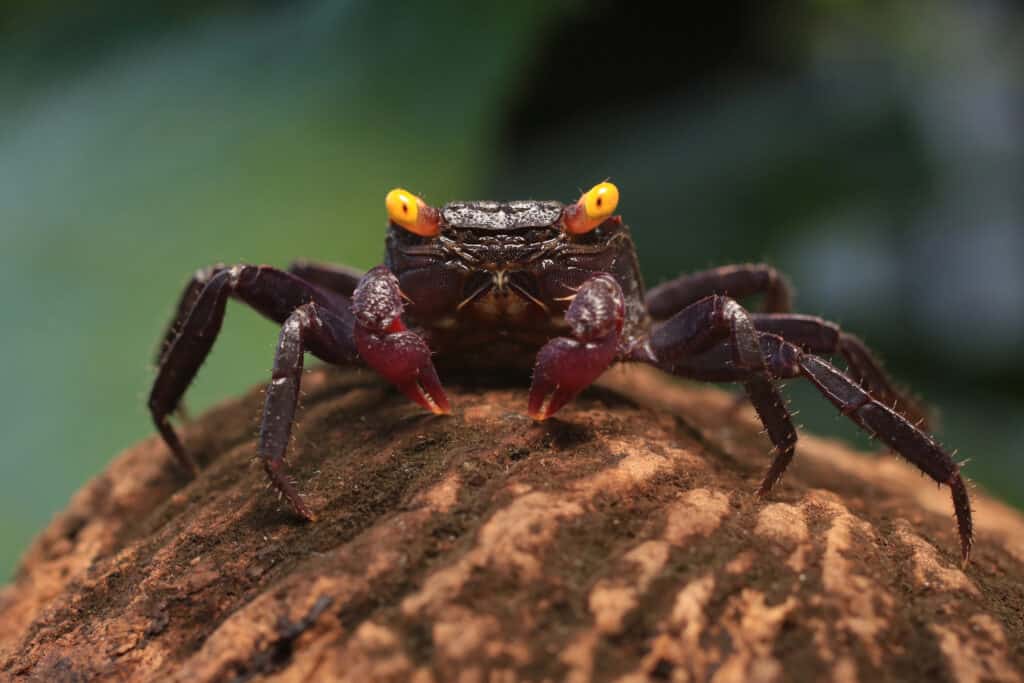Vampire Crab
Geosesarma dennerle
Vampire crabs do not depend on saltwater for their development; instead, they live near freshwater rivers and in forests amongst rocks and dense vegetation.
Advertisement
Vampire Crab Scientific Classification
- Kingdom
- Animalia
- Phylum
- Arthropoda
- Class
- Malacostraca
- Order
- Decapoda
- Family
- Sesarmidae
- Genus
- Geosesarma
- Scientific Name
- Geosesarma dennerle
Read our Complete Guide to Classification of Animals.
Vampire Crab Conservation Status
Vampire Crab Facts
- Prey
- Crickets, Grasshoppers, Earthworms, Mealworms, Woodlice and Springtails, Worms, and Plant detritus.
- Main Prey
- Crickets
- Name Of Young
- Zoea
- Fun Fact
- Vampire crabs do not depend on saltwater for their development; instead, they live near freshwater rivers and in forests amongst rocks and dense vegetation.
- Biggest Threat
- Over-collecting
- Most Distinctive Feature
- Yelow eyes
- Distinctive Feature
- Purple body
- Gestation Period
- 1 month
- Temperament
- Aggressive towards other species
- Incubation Period
- 1 month
- Litter Size
- 20 to 80 eggs
- Habitat
- Dense forests, rivers and lakes witha rocky terrain
- Diet for this Fish
- Omnivore
- Average Litter Size
- 20 to 80 eggs
- Lifestyle
- Nocturnal
- Favorite Food
- Crickets
- Common Name
- Vampire Crab
- Origin
- Java, Indonesia
- Number Of Species
- 2
- Location
- Java, Sulawesi, Riau, and Krakatau in Indonesia
Vampire Crab Physical Characteristics
- Color
- Yellow
- Cream
- Purple
- Skin Type
- Exoskeleton
- Lifespan
- 2 years
- Length
- 2 inches
- Age of Sexual Maturity
- 6 months
- Venomous
- No
- Aggression
- High
View all of the Vampire Crab images!
Vampire crabs do not depend on saltwater for their development; instead, they live near freshwater rivers and in forests amongst rocks and dense vegetation.
This tiny crab is one of the most popular tank pets these days, and everybody wants one. While vampire crabs don’t feed on blood as their name entails, they are nocturnal and are primarily active at night.
Vampire crabs differ from most crustaceans because they are semi-terrestrial, meaning they live most of their life on land and spend some of their time in the water.
These mesmerizing creatures are freshwater crustaceans first discovered in forests, rivers, and lakes on the Island of Java, Indonesia. Later, locals found them on small islands off the coast of Indonesia called Sulawesi, Riau, and Krakatau.
Vampire crabs have been popping up in aquariums for decades; however, they were only officially discovered in 2006. So, naturally, there is very little information available on their habitat and biology.
These crabs are tough little guys; they can thrive in the right environment but have a few unique care requirements.
Amazing Facts About Vampire Crabs
- These tiny crabs reach only 2 inches when fully grown, including their legs
- Males are slightly larger, and their claws are lighter than the females.
- Vampire crabs live up to their name and are nocturnal creatures
- These crabs are aggressive with other species of crab or small fish and will even attack or eat them, but they are civil with their own species.
- Vampire crabs don’t live that long; their lifespan is generally 2 years, but they can grow slightly older with proper care.
Classification and Scientific Name
The Vampire crab’s scientific name is Geosesarma dennerle. However, the reason for their common name (Vampire Crab) is a subject of debate.
Some believe that it’s because of their purple bodies and yellow eyes that resemble Dracula, while others think it’s because they have cream-colored spots on their bodies in the shape of bats.
Vampire crabs belong to the genus Geosesarma which includes semi-terrestrial crabs distributed widely across the eastern Indian Ocean, Southeast Asia, and the western Pacific. However, because they were only recently discovered, their taxonomy is still in a state of flux. The two recognized species within the genus are the:
- Vampire crab that is violet and cream in color (Geosesarma Dennerle)
- Red Devil Crab that is dark brown and bright orange (Geosesarma Hagen)
Vampire Crab Habitat
Vampire crabs are mainly found on the Island of Java, Indonesia, and their habitats include freshwater rivers, lakes, dense vegetation, and rocky terrain in the forest.
How to Identify Vampire Crabs: Appearance and Description
The vampire crab is hard to miss with its violet coloring, especially standing on its ten legs (which includes the pinchers). Their bodies are so dark that they almost look black and are covered in cream spots resembling a bat’s outline, which is why their yellow eyes stand out so much.
They are tiny little things, barely reaching 2 inches in length, including their legs; their body alone is only 1 inch wide.
While vampire crabs share the same primary characteristics as regular crabs, they still stand out and are easy to identify. For example, besides their coloring, they have very small pinchers; they are so tiny that they wouldn’t be able to hurt people easily.
There are several ways to differentiate between males and females, with the most obvious their size. Males are slightly larger than females, and their claws are lighter in color.
Another difference is their underbelly. The male’s abdominal flap is pointed, while the females are round and wider.
One more giveaway is the eggs. Once mating is successful, the female will carry around 20 to 80 fertilized eggs (depending on size) under her abdomen for about a month until they hatch.

Vampire crabs are tiny, reaching only 2 inches in length including their legs.
©Dan Olsen/Shutterstock.com
Vampire Crabs Diet
Vampire crabs aren’t picky eaters; they are omnivores and will eat nearly anything. In their natural habitat, these crabs will prey on:
- Living and dead crickets
- Grasshoppers
- Earthworms
- Mealworms
- Woodlice
- Springtails
- Worms
- Plant detritus
However, their diets are a bit different in captivity and can consist of:
- Brine shrimp
- Earthwork pieces
- Bloodworms
- Dried algae
- Shrimp
- Fish flakes
- Wafers
- Pellets
- Vegetables
- Dry leaves
Crabs join the group of crayfish, shrimp, and snails that require a lot of calcium to keep their exoskeleton healthy.
Vampire Crab Behavior
These crabs are semi-terrestrial and spend the majority of their lives on land and some of their time in the water.
When in an aquarium, the vampire crab will spend most of its time in the same spot. In addition, vampire crabs live up to their names and are primarily active at night (nocturnal.)
These tiny little crabs molt. Their exoskeletons protect them but do not grow with the rest of the body. So once their body grows too large for their exoskeleton, they must discard it to develop a new one.
Adult vampire crabs will molt once every 30 days. However, when they are younger, molting can be more frequent because they grow faster.
Vampire crabs are incredibly vulnerable once their protection is gone, and they will stay hidden until a new exoskeleton develops.
When in captivity, it’s important to remove the discarded exoskeleton from the tank and not do not touch the crab because even the slightest touch could harm it.
These tiny crabs have an aggressive streak and will clash with other species like small fish and other crabs. But, strangely, they tolerate their own species. They use their claws to attack but are not harmful to humans because their pinchers are too small.
Predators and Threats
Vampire crabs need to be wary of many predators in the wild. Any crab-eating animal is a threat to them. For example:
However, their biggest threat is the pet trade. Their bright colors and edgy name have piqued peoples’ interest, and over-collecting is starting to become a problem.
Reproduction and Lifespan
Once mating season is over, it takes about 30 days for the eggs to hatch. You can tell when the eggs are about to hatch when the female becomes more secretive and hides 24/7. Females can carry between 20 to 80 eggs under their abdomens, depending on their size. There are no larval stages because the eggs are large enough for direct development.
After hatching, females give live birth to fully developed miniature crabs. They are born in freshwater and only measure between 1 to 2 mm at birth.
The female stays with them and shields them under her abdomen for several weeks until they are big enough to venture out independently.
In addition, the zoea (baby crabs) turn into cannibals after brooding is over, so it’s best to separate the mother from the zoea if you want them to make it to adulthood.
This cannibalistic behavior also occurs during the molting season, so tanks must have an abundance of hiding places, or they should be separated by size.
Vampire crabs can live up to two years, but they can stick around slightly longer with extra love and care.
Caring for Vampire Crabs
The tank for a vampire crab will look very different from your average fish tank. This is because they require something called a paludarium setup. That means that there are land elements and water elements.
Vampire crabs are not equipped to stay in water for long periods of time and will drown. Therefore, 80% of their tank should be terrestrial and 20% aquatic. However, the minimum requirements are 50/50.
Tank Size
The rule of thumb regarding tank size is a 10-gallon tank for a group of six vampire crabs. The aquatic element can be a deep 4 to a 6-inch tray with just enough water to cover their bodies. In addition, tanks need a tight-fitting lid because vampire crabs are great escape artists.
Tank Environment
The vampire crab can only survive in a tropical environment. Therefore, the ideal temperature of the tank should be between 75°F – 82°F. Another factor that needs attention is the humidity level, which should be 75% or higher.
Water should always be clean, especially during molting and breeding periods. Vampire crabs are highly sensitive to dirty water, and it could result in illness, which can be fatal. To achieve clean and healthy water, swap it for fresh water every month.
Ensure the land element includes fine sand like gravel, sand, earth, or a sand-earth mixture, because they love to burrow, and fine sand will not harm their pinchers or shells.
Because they are usually found in dense forests, the tank must replicate that, and should be heavily planted in certain areas. In addition, they need multiple hiding spots, which could be made from PVC pipes, rocks, and driftwood, just to name a few.
What’s Next?
View all 25 animals that start with VVampire Crab FAQs (Frequently Asked Questions)
Do vampire crabs eat fish?
Vampire crabs aren’t picky eaters; they are omnivores and will eat nearly anything. However, they prefer live and dead crickets, grasshoppers, and earthworms.
Do vampire crabs fight?
These tiny crabs have an aggressive streak and will clash with other species like small fish and other crabs. But, strangely, they tolerate their own species.
Will vampire crabs eat each other?
The zoea (baby crabs) turn into cannibals after brooding is over, so it’s best to separate the mother from the zoea if you want them to make it to adulthood.
How much does a vampire crab cost?
A vampire crab generally costs between $10 to $20.
Can vampire crabs live underwater?
No, they will drown. Vampire crabs spend the majority of their lives on land.
Thank you for reading! Have some feedback for us? Contact the AZ Animals editorial team.
Sources
- Aquariadise / Accessed July 30, 2022
- Live Science / Accessed July 30, 2022
- Fish Laboratory / Accessed July 30, 2022
- Aquarium Breeder / Accessed July 30, 2022
- Wikipedia / Accessed July 30, 2022
- Fish Keeping World / Accessed July 30, 2022


















